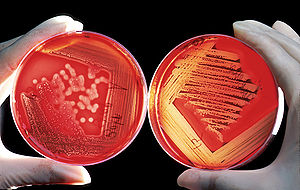
- Image via Wikipedia
Infections in human beings are caused by a frightening array of microorganisms. Bacteria, viruses, fungi, yeast, worms, amoeba, parasites, and prions invade the human body, spreading fear and misery throughout the world.
In a very real sense, every infection is caused by an interaction with the environment. The world is a germy place, and it’s amazing we’re all as healthy as we are. To understand human infection you must understand the human environment, both external and internal. The food we eat, the water we drink, the air we breathe, and everything we touch are all potential sources of infection. Even our own bodies may betray us. Our skin is a playground for mites and bacteria. Our mouths and intestines are a nursery for a whole civilization of microorganisms.
All infections result from tiny organisms penetrating barriers designed to protect us. They may enter our body through any opening: eyes, ears, nose, mouth, urethra, rectum, vagina – even occasionally our belly buttons. A tiny crack in the skin, a bug bite, or irritated hair follicle is all that’s needed to afford a portal for entry. Once these unwelcome visitors get a foot in the door, they may take over without our knowledge or permission.

- Image by angela7dreams via Flickr
Humans and animals share multiple barriers to infection. Skin, hair, fur, scales, hooves, and feathers all help keep microorganisms from invading. The naked ape adds shoes and clothing to this armamentarium, as well as bathing and other sanitary practices. Additionally, the germs that thrive on healthy individuals, our ‘normal human flora’, protect their own territory from nasty invaders. Having good intestinal germs helps limit the harmful ones. The mucus that coats our airways and intestines helps trap undesirable microorganisms, and the action of cilia (tiny hairs) helps carry them away. Stomach acid tolls a death knell to most bacteria. Skin oil helps keep our skin supple and healthy. Tears wash dust and germs from our eyes. Ear wax not only helps keep the bugs out, but helps prevent infection. Our bodies are wonderfully designed to prevent outside invasion and to repair themselves.
Preventing Infection
Obviously, prevention is the name of the game. The primary goal is to keep germs from invading the body by maintaining intact natural barriers. The largest and most obvious barrier to infection is the skin. Healthy skin requires a healthy diet with sufficient calories, protein, essential fats, vitamins, minerals, and other nutrients. Unless you have a skin disease, adequate nutrition, gentle cleansing, and adequate lubrication are the keys to maintaining intact skin.
What is appropriate cleaning? In America, we bathe too much. Many problems are caused by the chemicals we use to clean, deodorize, perfume, exfoliate, tan, bleach, and otherwise camouflage our skin. Just leave it alone! Bathing with clean water and perhaps a gentle soap is all you need. Doing more dries the skin, allowing cracks to form and bacteria and viruses to invade. Although using hand cream may help, it’s not the same as allowing your own skin oil to do the job it was designed to do.
Proper drying of the skin is also essential. Yeast and bacteria thrive in warm, wet areas, irritating the skin especially where it rubs together. The skin may become red, raw, itchy, and oozing, leading to a cycle of more of the same. Allow skin folds to air dry, or blot gently. Rubbing irritated areas will only make the problem worse.
Less frequent bathing is required when clothing is used as additional protection. Wear socks and good-fitting shoes, long pants, long sleeves, and head-covering whenever there is threat of contamination or injury. Injury to the skin and subsequent infection also occurs from shaving, plucking, trimming, and cutting.
Even small injuries can lead to major infections. I’ve seen people require hospitalization when a sunburn, or bug bite, or a blister, or simply dry skin became infected. Watch out for scratches, frostbite, lacerations, abrasions, chemical burns, friction, poison ivy, insect stings. Any time the skin is damaged, the likelihood of infection skyrockets.
Starting at the top, here are several other ways to prevent infection, from head to toe:
1. Don’t use Q-tips. Many patients get ear infections from removing the protective coating of earwax, or from scraping their ear canals in the process. As with the skin, just leave your ears alone.
2. Don’t rub or touch your eyes. Bacteria and virus are often transmitted to the eyes via the hands causing conjunctivitis (pink eye) and respiratory infections. As with the ears, leave your eyes alone. Rubbing the eyes may cause tiny abrasions, allowing infection to invade.
3. Don’t pop your pimples. Surely you know it only makes things worse. Although acne bacteria cause inflammation (not true infection), breaching the skin may allow staph and strep germs to invade, causing a true infection.
4. Don’t touch your nose. Many microorganisms that cause colds, flu, bronchitis, and pneumonia are often transmitted to the nose via the hands.
5. Avoid food and drink that leaves the mouth raw or inflamed, including hot liquids, spicy food, tobacco, and alcohol. Although this is more likely to cause uncomfortable inflammation than infection, viruses such as herpes are more likely to invade damaged skin and mucosal membranes.
6. Avoid potentially contaminated food and drinks, to decrease the possibility of food poisoning, giardia, worms, hepatitis A, and gastroenteritis.
7. Cherish your stomach acid. With the increased use of acid-lowering drugs in recent years, there has been growing concern that gastrointestinal infections may increase. Hydrochloric acid is a potent sterilizing agent, killing off most germs that we ingest along with our food and drink. In 2010 it was demonstrated that clostridium difficile colitis organisms are more difficult to eradicate in patients taking strong acid-lowering medications.
8. Avoid bubble baths or strong soaps in the genital areas, especially in little girls and women. The minor irritation this causes often leads to urinary infections. Drinking plenty of liquids and urinating frequently also helps flush the urinary system of bacteria.
9. Practice safe sex. Monogamy with a trusted infection-free partner or total abstinence is the only ways to be 100% safe. If this is impossible, stock up on condoms to protect yourself and society from spread of disease. If you’re worried, get checked now for sexually transmitted diseases, and treat yourself and partner if needed.
10. Check your feet regularly. For diabetics or people with poor circulation or numb feet, this should be daily. For others, watch for blisters, bug bites, athlete’s foot, warts, injuries, abrasions, and rashes.
11. Avoid antibiotics when possible. For decades the use of antibiotics has resulted in iatrogenic yeast infections and resistant bacterial strains. Now the problem is worsened with the widespread prevalence of both clostridium difficile colitis and methacillin resistant staphylococcus aureus, both potentially lethal infections.

- Image via Wikipedia
Treating infection and Rational Rationing
Despite your best precautions, infections will inevitably occur. Nowadays – in times of plenty – most patients take antibiotics out of fear: fear of discomfort, fear of missing work, fear of being inconvenienced. In times of scarcity, people will still take antibiotics out of fear, but the stakes will be higher. No more antibiotics for acne, for viruses, for minor infections. People will take antibiotics out of fear of death, deformity, or disability.
Who should be treated? Who should not? The question of health care rationing raised its ugly head during the health reform debates. But that was child’s play, compared to the rationing that will – that must – occur when Armageddon strikes.
Although I can tell you what medicine to use for a specific problem, I cannot tell you precisely who should receive treatment. In modern society, we think mostly of ourselves, our own survival. In uncertain times the survival of the family, the clan, humanity itself may be at risk. Is a child more important than a breadwinner? Is a physician more vital than a priest? Will you find yourself in a group that must decide?
Until manufacturing capabilities are reestablished, medical supplies will be limited. Rationing will occur, but will rationing be rational? Or will the greedy and powerful prevail? If you only have one bottle of penicillin, seek wisdom in your rationing.
* * *
The above entry is excerpted from my upcoming book entitled Armageddon Medicine, Copyright ©2010-2011 Cynthia J. Koelker, MD
* * *
Future posts will address issues of infection in more detail.
Related articles by Zemanta
- Avoiding Illness from Everyday Germs (aolhealth.com)




Are there any OTC silver preparations? Silvadene has been my stand-by at work for all sorts of things, but might not be so easy to get a doctor to prescribe just to have on hand.
An old fashioned tar-based remedy I have had good success with is Icthammol ointment 20%. It’s hard to find now, except on the internet. Mostly used as a vet remedy but works great on skin ailments, minor cuts and so on.
Now that silvadene comes generic for $4 your doctor might be more willing to prescribe to have on hand. When I worked in Kentucky, the “natives” also used “the black drawin’ salve” (Ichthammol) with good results. That would be a good topic for a post.
I have used silver (24ppm) in a water based gel. I bumped my elbow and got a very bad infection. Cellulitis in fact. My wife went to the health food store and he said he had someone use the silver on his skin MRSA. I did the same, and call it a coincidence, but the infection was 90% gone in 3 days.
Silver is well known for it’s antibacterial effects. In fact, the toilets in my home are coated with some sort of silver to cut down on bacteria. I keep a tube of this stuff in my emergency bag now, right by the triple antibiotic gel.
Doctor Koelker,
Have you ever used honey to fight an infection on a wound? I have read that in World War II some doctors in England used it over some wounds and had great success in fighting infections. Thanks for your time.
[From Dr. Koelker – Though I have not (yet) had experience using honey for wound management, the literature does support a role for this. Sounds like a great idea for a chapter in my upcoming book, as well as a post on Armageddon Medicine. I’ll put my mind to it shortly. Thanks for the tip.]
Thanks for the info
Thanks, Benny. I’m checking this out in the medical literature. For now I’ll say that we still use silver sulfadiazine for burns and other open wounds. It’s available only as a prescription. More comprehensive answer to follow.
Doc: I love the site on infections,and while I realize that you’ve got a lot on your plate right now, I have to ask: Have you tried or do you have any experience with Colloidal Silver for treating infections? I’ve used it a few times and it seems to work, particularly topically, and I’ve talked to many who swear by it. I also know what silver, silver iodide and other silver potions were used for by the medical establishment pre penicillin.Your comments?